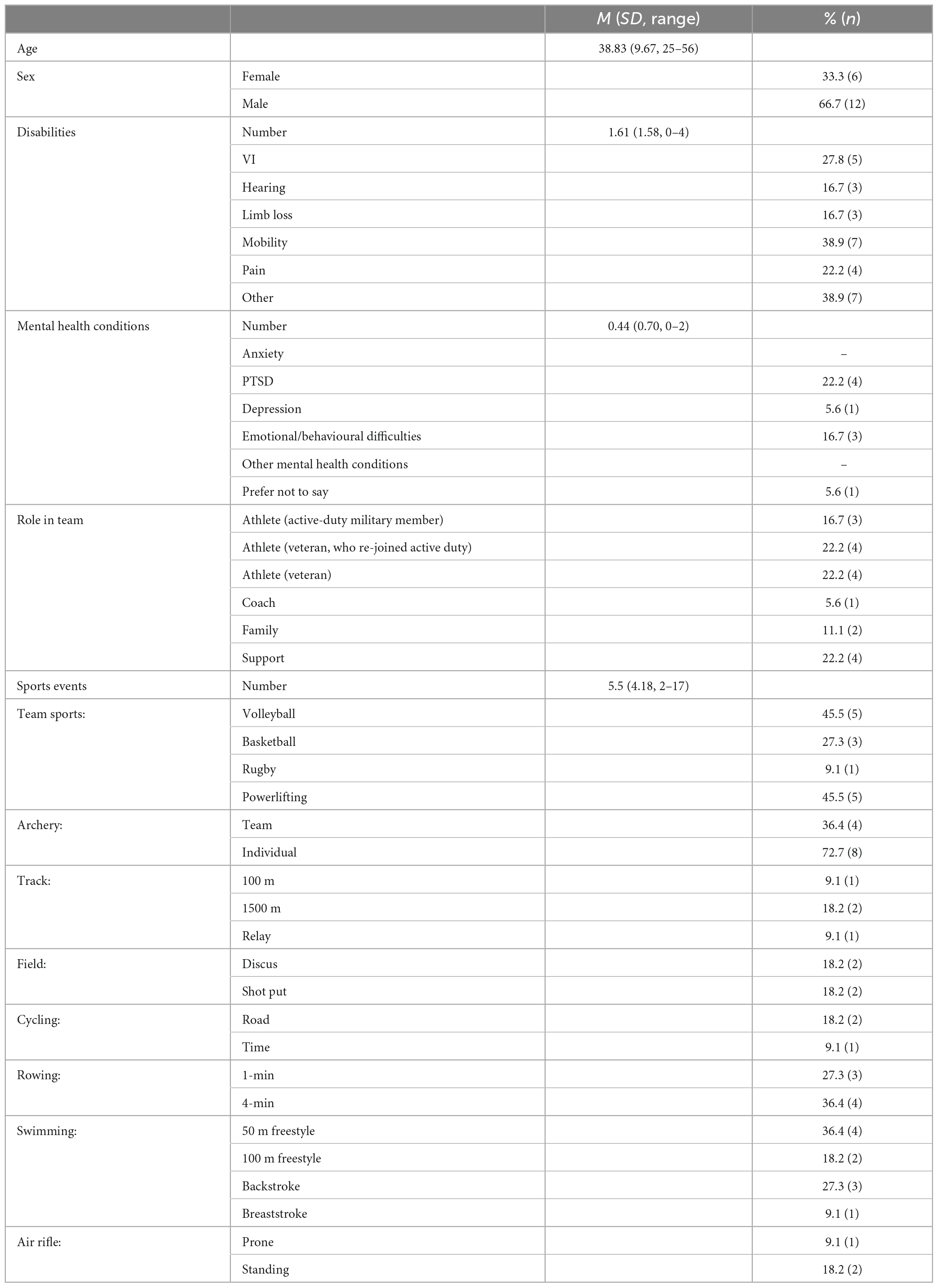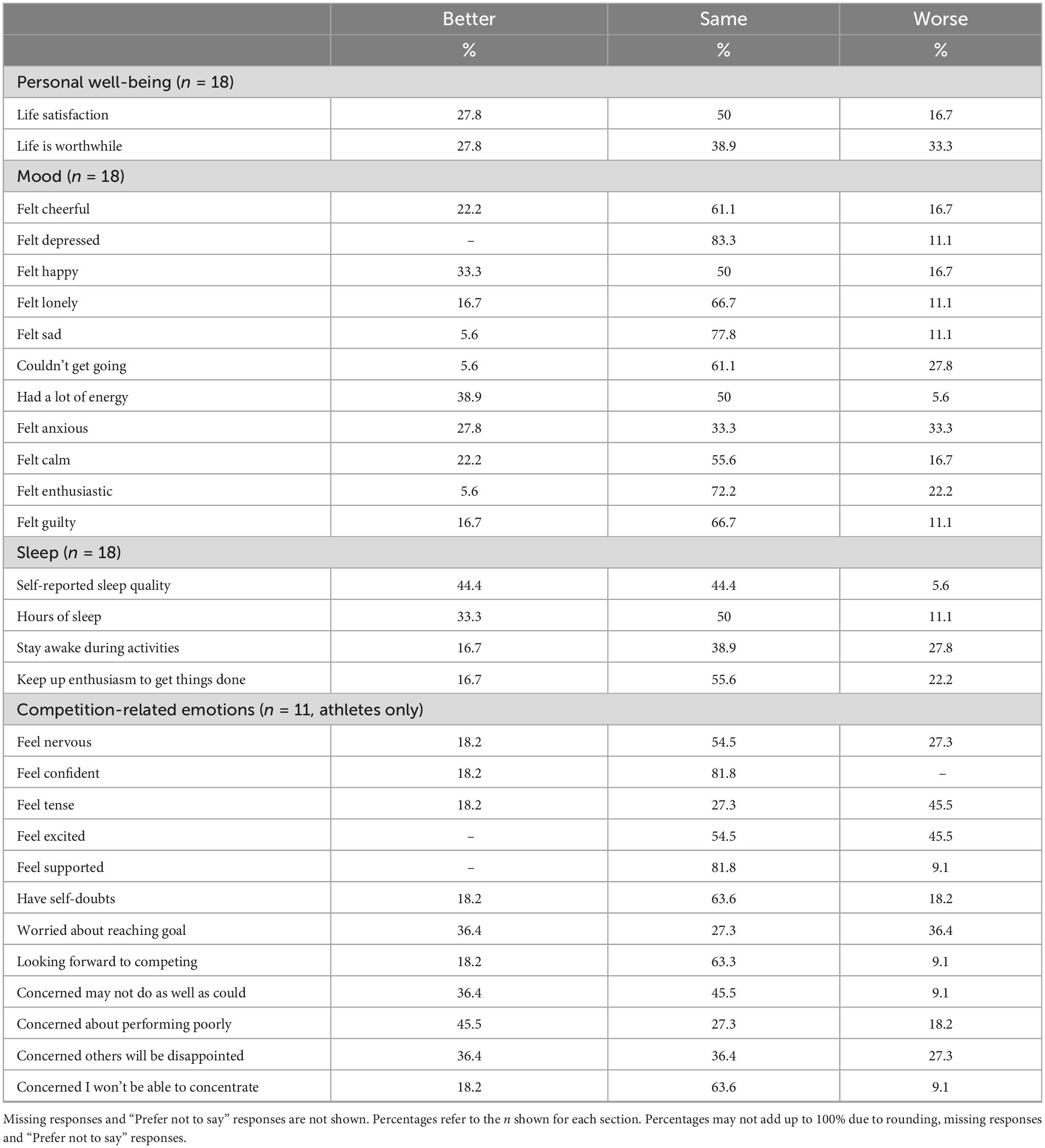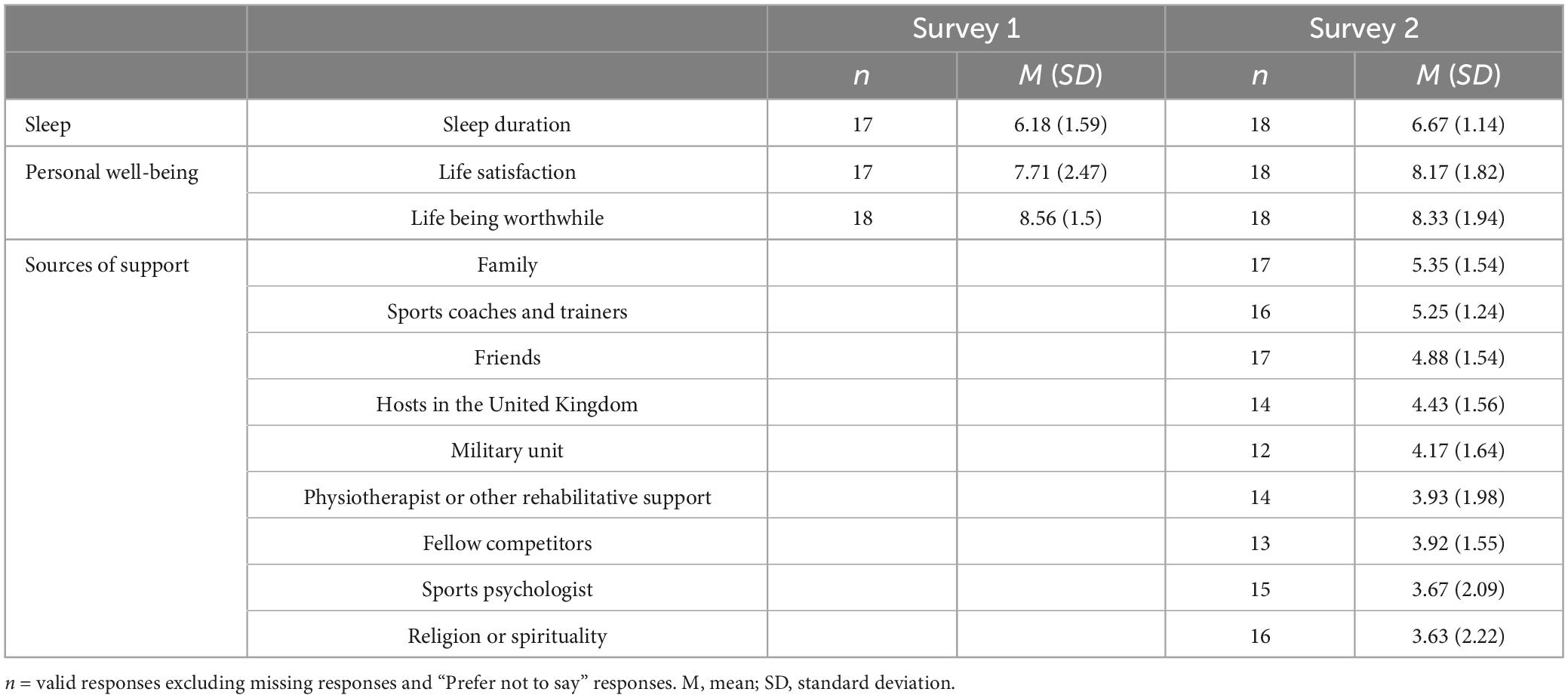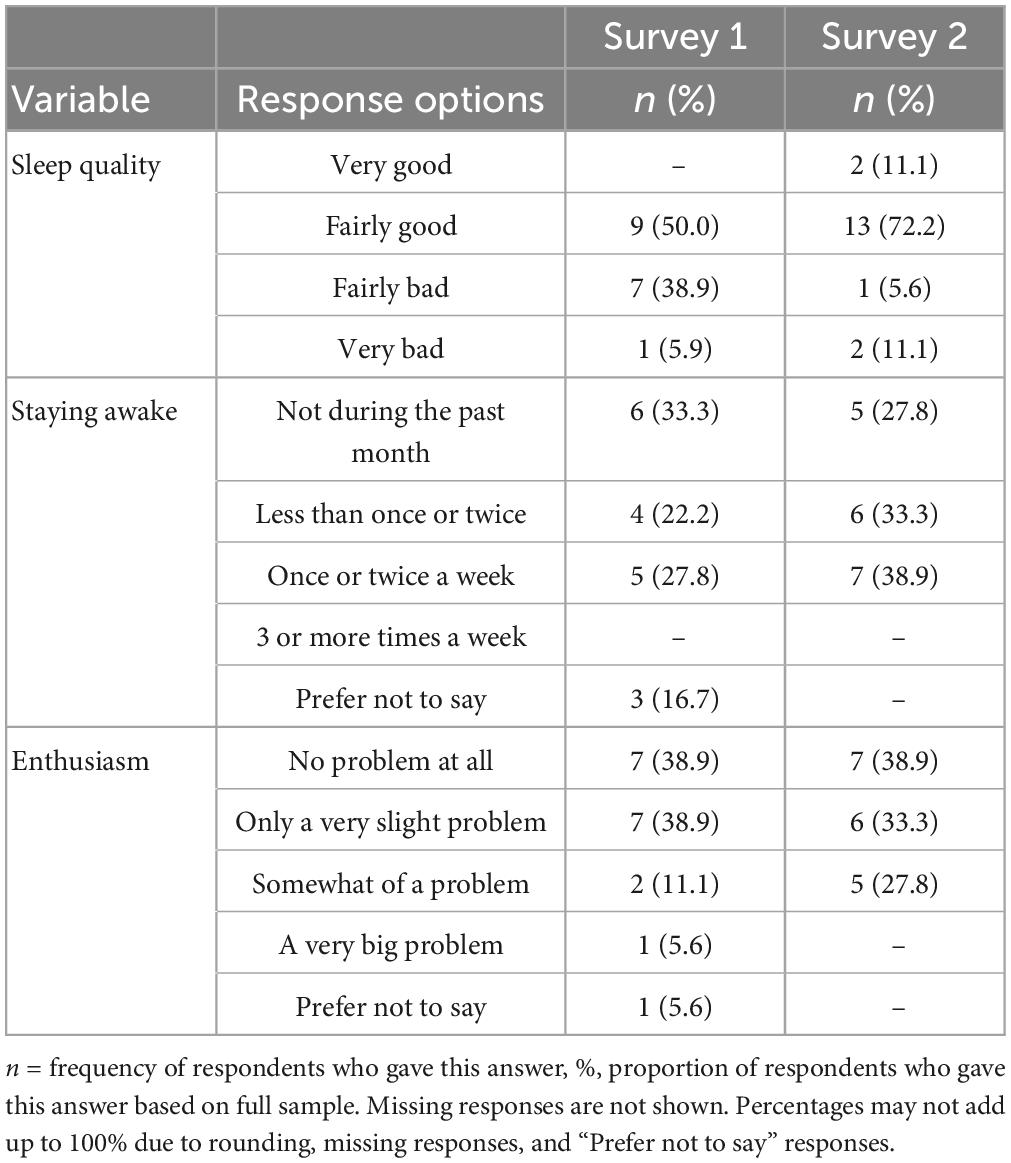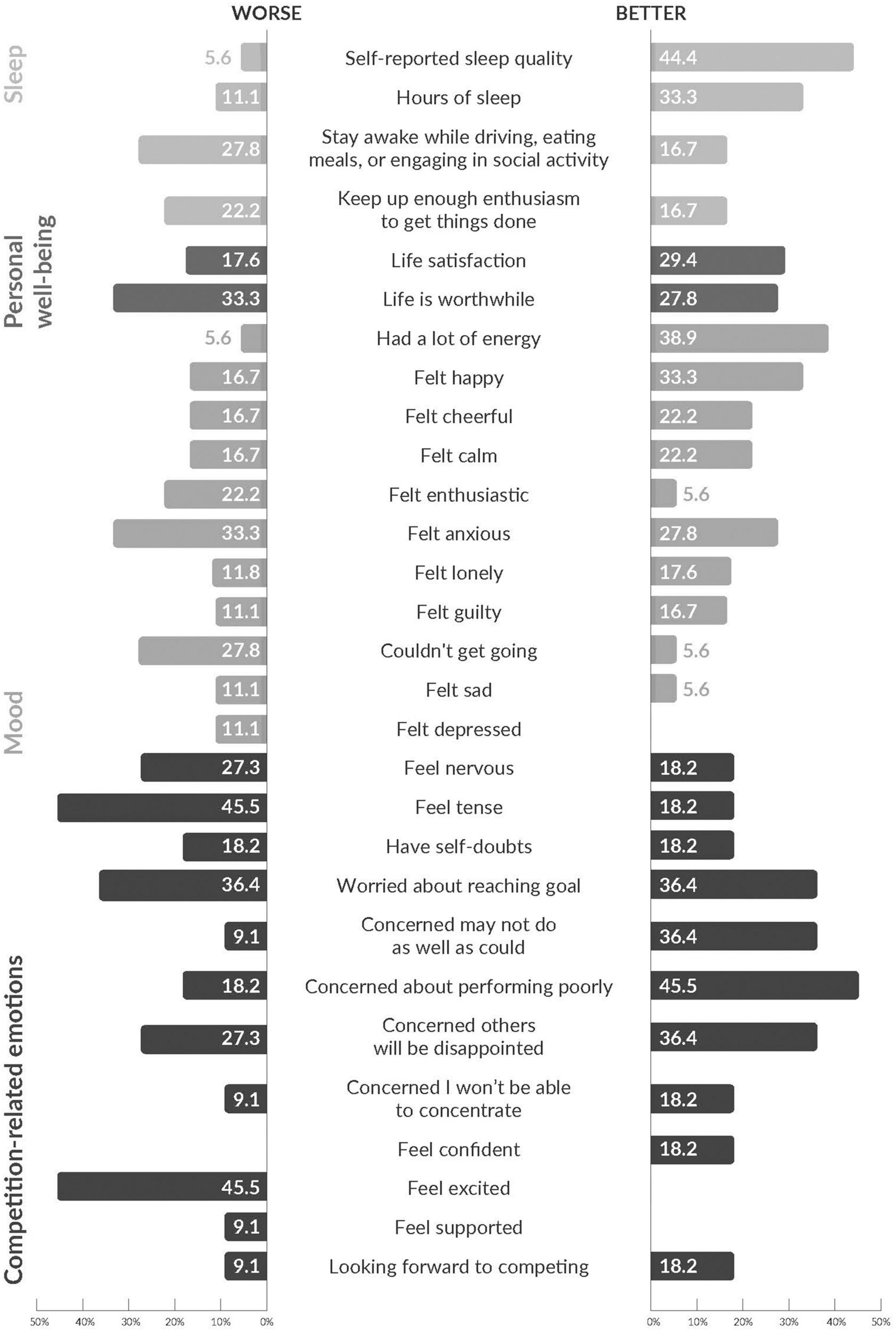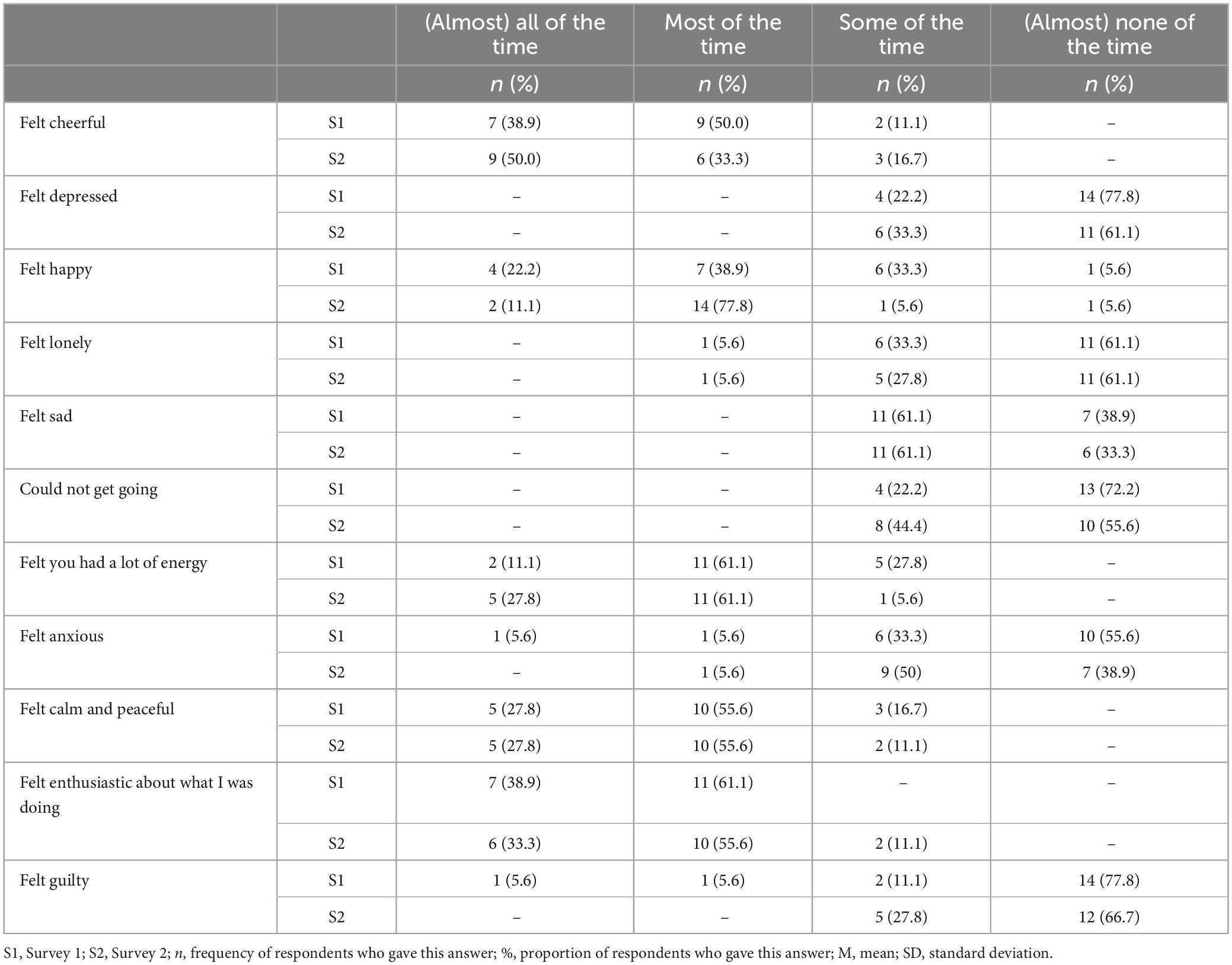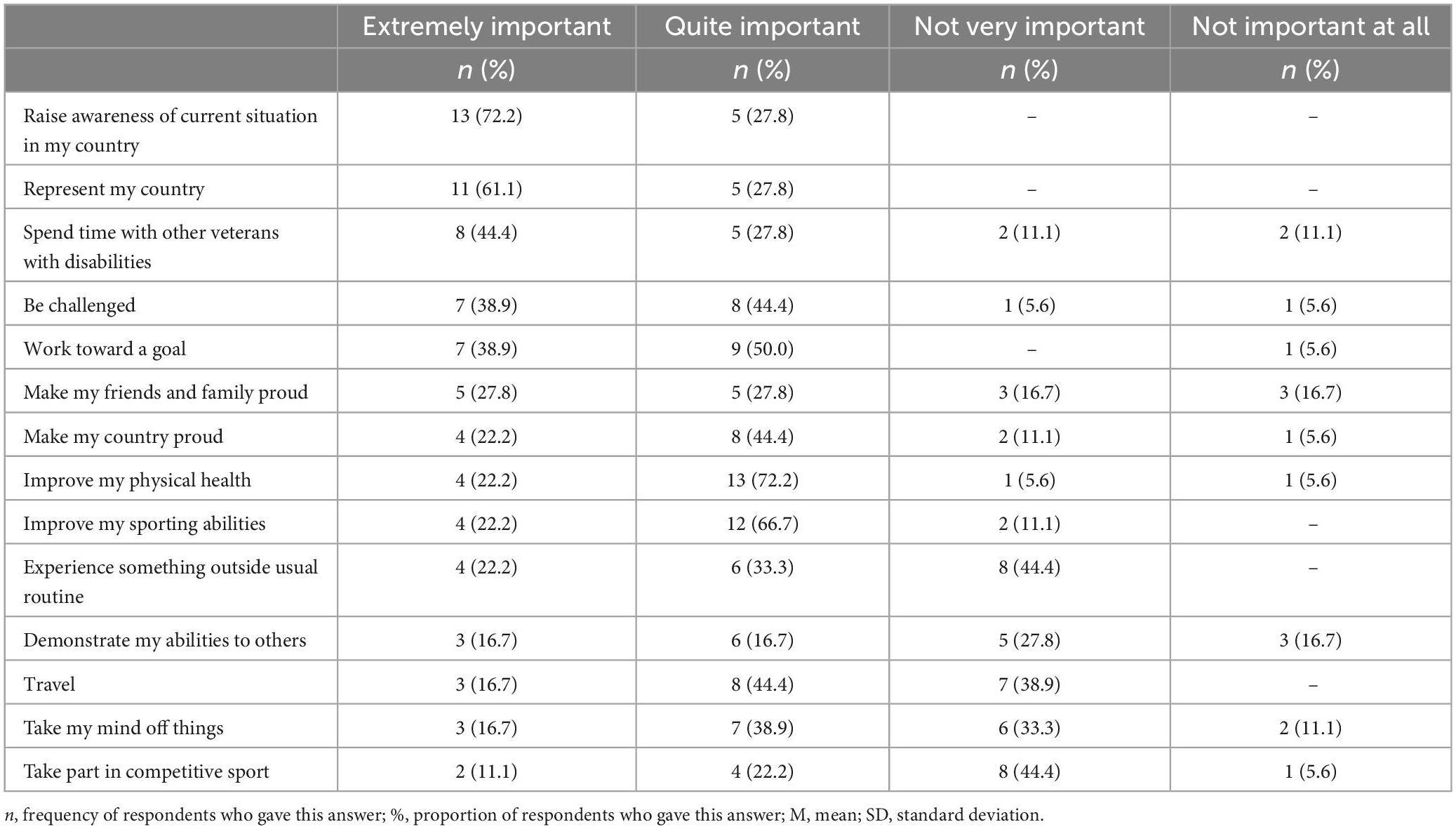- 1BRAVO VICTOR, London, United Kingdom
- 2School of Music, Faculty of Arts, Humanities and Cultures, University of Leeds, Leeds, United Kingdom
- 3Northern Hub for Veterans and Military Families Research, Department of Nursing, Midwifery and Health, Faculty of Health and Life Sciences, Northumbria University, Newcastle upon Tyne, United Kingdom
Purpose: The benefits of sports and exercise to the lives and rehabilitative journeys of military veterans with disabilities is increasingly well-documented but veteran sporting events remain underexplored. Addressing this topic, the current article seeks to provide insight into the health and well-being of Team Ukraine during a 5-week preparatory camp in the UK before attendance at the 2022 Warrior Games.
Materials and methods: Two surveys were run, one toward the beginning and one toward the end of the camp. Eighteen of the 55 veterans and serving personnel (with disability), support staff, and family members in attendance responded to both surveys. Data on sleep, mood, and competition-related emotions, motivations for participation and perceived support were gathered. Data were analysed descriptively, and sleep, mood, and competition-related emotion responses were categorised to explore improvements, maintenance, or worsening in these areas.
Results and conclusion: Sleep, mood, and competition-related emotions were relatively stable, although sleep duration was low, and there were some increases in daytime dysfunction, anxiety, nervousness, and feeling tense. Family was the most important source of support and representation of one’s country and raising awareness of Ukraine’s circumstances were the most important motivational factors. Findings offer insight into not only the health and well-being experiences associated with participation in this disabled veteran sporting event, but also the important role played by this event in meeting collective goals relating to this unique time in Ukraine’s history.
Introduction
Research highlights the benefits of sports and physical activity to the lives and rehabilitative journeys of military veterans (Caddick and Smith, 2014). Veterans with traumatic injuries or chronic illness have noted the motivating nature of sports, with a focus on capacity and success rather than illness or injury, and the availability of immediate short- and long-term feedback when participating in sports (Brittain et al., 2022). Participation in sports and physical activity has been associated with improved subjective (e.g., active coping and social participation), psychological (e.g., increased determination, focus on ability, improved self-concept), and social well-being among combat veterans (Caddick and Smith, 2014). Furthermore, physical benefits such as increased mobility, strength, and aerobic capacity (Addison et al., 2019; Briggs and Oursler, 2021), weight loss and increased fitness (Brittain et al., 2022), and reductions in the symptomology of mental health conditions such as post-traumatic stress disorder (PTSD) have been identified in veterans with disabilities, traumatic injuries or chronic illness (Walter et al., 2021). Outdoor and nature-based activities, such as fishing, water and snow sports, riding, and archery, have been found to provide a wide range of benefits to veterans, including facilitating positive mood and establishing new coping methods through motivation and challenge (Bennett et al., 2017; Craig et al., 2020), opportunities for social bonding (Lundberg et al., 2016), as well as reductions in PTSD symptomology (Gelkopf et al., 2013; Crawford, 2016; Wheeler et al., 2020).
Literature has also explored the experiences, benefits, and challenges of participating in sporting events for veterans with disabilities (Roberts et al., 2019, 2021). Participants at the National Veterans Wheelchair Games (NVWG) and Winter Sports Clinic (NVWSC, both held in the USA) reported increased mobility and acceptance of their disability (Sporner et al., 2009). Invictus Games competitors have cited improvements in physical and mental health and performance, and social interactions (Roberts et al., 2021), opportunities to develop goal-setting and teamwork skills, and a chance to reconnect with a military identity (Brittain et al., 2022). Research has also considered the experiences of participants of The Warrior Games (run by the USA’s Department of Defence). Peterson et al. (2017) found that time spent participating in organised sporting events impacted on skills relating to performance strategy, with those who had participated for over a year demonstrating greater skills relating to self-talk, goal setting and activation prior to competition than those who had less than 1 year of experience. Similarly, Laferrier et al. (2017) found that registered athletes at the NVWSC, the Warrior Games, and the NVWG, had significantly higher self-esteem scores than those not involved in sports and exercise, with this score also being significantly higher immediately following participation in a sporting event compared to 1 and 3 months after an event. Participation in sports and exercise was also associated with significantly lower scores on depression measures, and higher post-traumatic growth and quality of life scores. Those who had been participating in sports and exercise for longer periods also scored significantly higher on measures compared to those who had participated for less time. However, negative experiences have also been identified, such as a perceived lack of goals after the games, “post-games blues,” and experiences of stress before and during the games (Roberts et al., 2019, 2021). Veteran sporting events remain an underexplored topic, and there has been limited research in this area in recent years due to the cancellation of events during the COVID-19 pandemic.
In 2022, the United States Department of Defence invited Ukrainian veterans and personnel injured in the current conflict to compete alongside American and Canadian service teams in the Warrior Games (“the Games”) held in Florida. The Games were attended by 61 Ukrainian competitors and support staff, including a small number of widows and children of deceased personnel; 55 of these individuals attended a training camp in the United Kingdom (UK) to prepare for the Games, hosted by Blind Veterans UK. Veteran participants were airlifted directly from an active warzone and military duties. The camp consisted of an intensive 5-week schedule of training sessions, psychotherapy sessions, and recreational trips. This camp provided an opportunity to gain unique insight into experiences associated with Team Ukraine’s preparations for the Games. The current study aimed to explore aspects of the team’s health and well-being during this time, and factors that might impact on their experiences of preparing for the Games. Addressing this objective, the current article answers the following questions:
(1) How, if at all, did mood, well-being, sleep, and competition-related emotions change in members of Team Ukraine over the course of their UK-based preparations for the Games?
(2) What motivations for participation in the Games were most important to members of Team Ukraine?
(3) What sources of support were perceived as most important to Team Ukraine during their preparations for the Games in UK?
Materials and methods
Two online surveys were conducted, one at the start and another at the end of the camp, to gather quantitative data relating to demographics, health and well-being, motivations for participation, and perceived support. Open-ended questions collected qualitative data on participants’ preparations, motivations, goals, and achievements. The current article reports quantitative findings only. Run as part of the evaluation of the training camp, the current study did not require approval from an ethics panel; this was confirmed by the Chair of the Medical Sciences Interdivisional Research Ethics Committee at the University of Oxford.
Participants and recruitment
A total of 55 veterans, current serving personnel, widowed spouses and support staff were airlifted out of Ukraine by the British military to attend the training camp in the UK to prepare for the Games. All 55 members of Team Ukraine who attended the training camp were invited to take part in the surveys. Participation was voluntary. The Ukrainian team leadership notified the team of the study. Participants were able to access the surveys using a link or QR code in a flyer provided in English and Ukrainian. The team leadership also shared a link via a private communication app accessible only to the team. A member of the research team was present throughout the camp to answer any questions.
Materials
Surveys 1 and 2 gathered data on sleep, mood, well-being, and competition-related emotions. Survey 1 (S1) explored age, type of disability, role in team, participation in different sporting events, previous sporting competition experience and motivations for taking part in the Games. Survey 2 (S2) assessed gender and asked participants to reflect on the importance of different sources of support during their preparations.
Questionnaires for both surveys were designed to minimise the impact of the research on the team’s training schedule and preparations for the Games. As such, relevant individual items were selected from existing scales or surveys or developed for the survey. Sleep was assessed using four items from the Pittsburgh Sleep Quality Index (PSQI) (Buysse et al., 1989). The full PSQI scale score has an internal consistency of α = 0.83 and a test–retest reliability of r = 0.87 (Buysse et al., 1989). The items selected in the current study explored subjective sleep quality (one item), sleep duration (one item), and daytime dysfunction (two items). Ukrainian translations were obtained from the MAPI Research Trust.
Mood was assessed using 10 items from the Ukrainian version of the European Social Survey (2010) (ESS). The items explored how often people felt, for example, “depressed” or “happy” in the past week. Responses were selected from a scale ranging from “None or almost none of the time” to “All or almost all of the time.” One item, “Felt guilty,” was added to acknowledge the guilt that those involved in active duties might experience when absent from their unit and comrades in Ukraine.
Personal well-being was assessed using two items from the ONS-4: life satisfaction and feeling like life is worthwhile (Office for National Statistics, 2018). The ONS-4 have been assessed through multiple waves of cognitive interviews and are regularly included in large general population surveys in the UK. The items require participants to give a response on a scale of 0 to 10 (where 0 is “not at all” and 10 is “completely”) to indicate the extent to which they feel satisfied with life and like life is worthwhile. ONS-4 items relating to anxiety and happiness were omitted to avoid duplication with ESS items.
Competition-related emotions were assessed using items addressing current anxiety relating to the upcoming competition from all three subscales (Worry, Concentration Disruption, Somatic Trait Anxiety) of The Sport Anxiety Scale-2 (SAS-2) (Smith et al., 2006). Participants were asked to rate the extent to which they felt a certain way from 1, “not at all” to 4, “very much.” Additional items, “I feel… confident/excited/supported” and “I am looking forward to competing” were included to explore positive emotions. Total score alpha coefficients exceeding 0.89 have been reported across all age groups (including children and adults) for the SAS-2 (Smith et al., 2006), suggesting internal consistency. The SAS-2 has been found to be reliable, gender invariant, and to have strong construct validity (Madrigal et al., 2018), although, it has not yet been validated with a Ukrainian sample. In the current study the full sub-scales were not employed; only items dealing with current, state, anxiety (e.g., “I feel nervous”) and not hypothetical experiences (e.g., “My mind wanders during sport competition”) were included. This reflected the need to minimise participant burden and training disruption.
A question was developed for S1 to assess participants’ motivations for their involvement in the Games. Participants were asked to rate how important a range of 14 possible reasons, such as spending time with other veterans or representing their country, were in their decision to take part in the Games, on a scale ranging from “extremely important” to “not at all important.” The importance of different sources of support was assessed with a question developed for S2. This question asked participants to rate on a scale ranging from 1, “not at all” to 6, “completely,” how important nine different sources of support (e.g., their unit, family, or fellow competitors) were to them during their preparations. All questions included a “Prefer not to say” response option.
Except for questions where Ukrainian translations were available, the questionnaires were translated into Ukrainian by a professional translation agency and checked by a member of Team Ukraine.
Procedure
S1 was run the second week of Team Ukraine’s time in the UK (22nd–26th July) and S2 ran during their final days in the UK (14th–18th August). Paper and English versions were available, but all participants completed the surveys online in Ukrainian. The surveys were delivered using the online survey platform SmartSurvey. An accessible survey template was used to ensure accessibility for participants with visual impairment. Participants were provided with an information sheet and required to provide informed consent at the beginning of S1. Participants reconfirmed their consent to participate before completing S2.
Analysis
Due to the selection of individual items from scales, no full-scale scores were computed. Frequencies of responses are reported, along with descriptive statistics such as mean, standard deviation and range where relevant. These provide an overview of sample demographics, sleep, mood, well-being, and competition-related emotions at the two timespoints, and data relating to motivations for participation and perceived sources of support. Change scores were created to explore if respondents’ sleep, mood, well-being, and competition-related emotions had improved, stayed the same, or got worse. Due to the small sample size, comparative statistical analysis and subgroup analysis was not undertaken.
Results
Demographics and upcoming sporting events
After excluding 2 partial responses, a total of 18 of the 55 camp attendees completed both surveys (36% response rate). Table 1 shows sample demographics, and the events competitors participated in. Respondents were aged 25–56 years (M = 38.38 years, SD = 9.67). Six respondents were female (33%). The sample consisted of 3 military personnel on active duty (16.7%), 4 veterans who had re-joined active duty (22.2%), 4 veterans (22.2%) (collectively referred to throughout as the “veteran” group), 4 members of support staff (22.2%), 2 family members who had taken the place of fallen team members (11.1%), and one coach (5.6%). Respondents reported an average of 1.61 disabilities (SD = 1.58, range: 0–4), most commonly disabilities affecting mobility (n = 7). Seven also reported “Other” disabilities, whilst 5 reported a visual impairment (VI), 4 a chronic pain condition, 3 a hearing impairment, and 3 limb loss. Six participants reported multiple disabilities. Mental health conditions were evident but less prevalent; PTSD was most common (n = 4), followed by emotional or behavioural difficulties (n = 3). Health data was self-reported and may not have reflected clinical diagnoses. Respondents participated in an average of 3.83 (SD = 4.33) and a maximum of 17 sporting events.
Sleep and mood
For most participants sleep, life satisfaction, life being worthwhile, and mood did not change between the surveys (Table 2). There was a small increase in mean sleep duration (from 6.18 to 6.67 h) (Table 3), and minimum sleep duration (from 3 to 4 h). However, participants were more likely to report poorer sleep duration at S2 than improved sleep duration. The proportion of participants who rated their sleep quality as “fairly” or “very good” increased from 50.0% at S1 to 83.3% at S2, but the number of participants who reported “very bad” sleep also increased from 1 to 2 (Table 4). In contrast, instances of daytime dysfunction, including difficulties staying awake during the day and keeping up enthusiasm to get things done, appeared to increase at S2 (Table 4). Whilst sleep quality and duration improved for a greater number of individuals than it worsened, the 2 daytime dysfunction items worsened for a greater number of individuals than the number for whom it improved (Figure 1).
Mean life satisfaction increased from 7.71 (SD = 2.47) to 8.17 at S2 (SD = 1.82) but mean life being worthwhile decreased slightly from 8.56 (SD = 1.50) to 8.33 (SD = 1.94). As seen in Figure 1, more people felt cheerful, happy, full of energy and calm more often, and lonely and guilty less often, at S2. However, more people also felt depressed, sad, that they couldn’t get going and anxious more often, and enthusiastic less often. For instance, while 61.1% felt happy at least most of the time at S1, this increased to 88.9% at S2. A greater number of respondents felt anxious “some of the time” at S2, and a smaller number felt anxious “none or almost none of the time” (Table 5).
Competition-related emotions
Competition-related emotions stayed largely the same among the 11 athletes competing in the Warrior Games (Table 6). A greater number of respondents improved than worsened for 6 of the 12 items: “Feel confident,” “Looking forward to competing,” “Concerned may not do as well as could,” “Concerned about performing poorly,” “Concerned others will be disappointed,” “Concerned I won’t be able to concentrate” (Figure 1). However, a greater number of respondents felt more nervous and tense, and less excited at S2 than the number that reported improvements on these items.
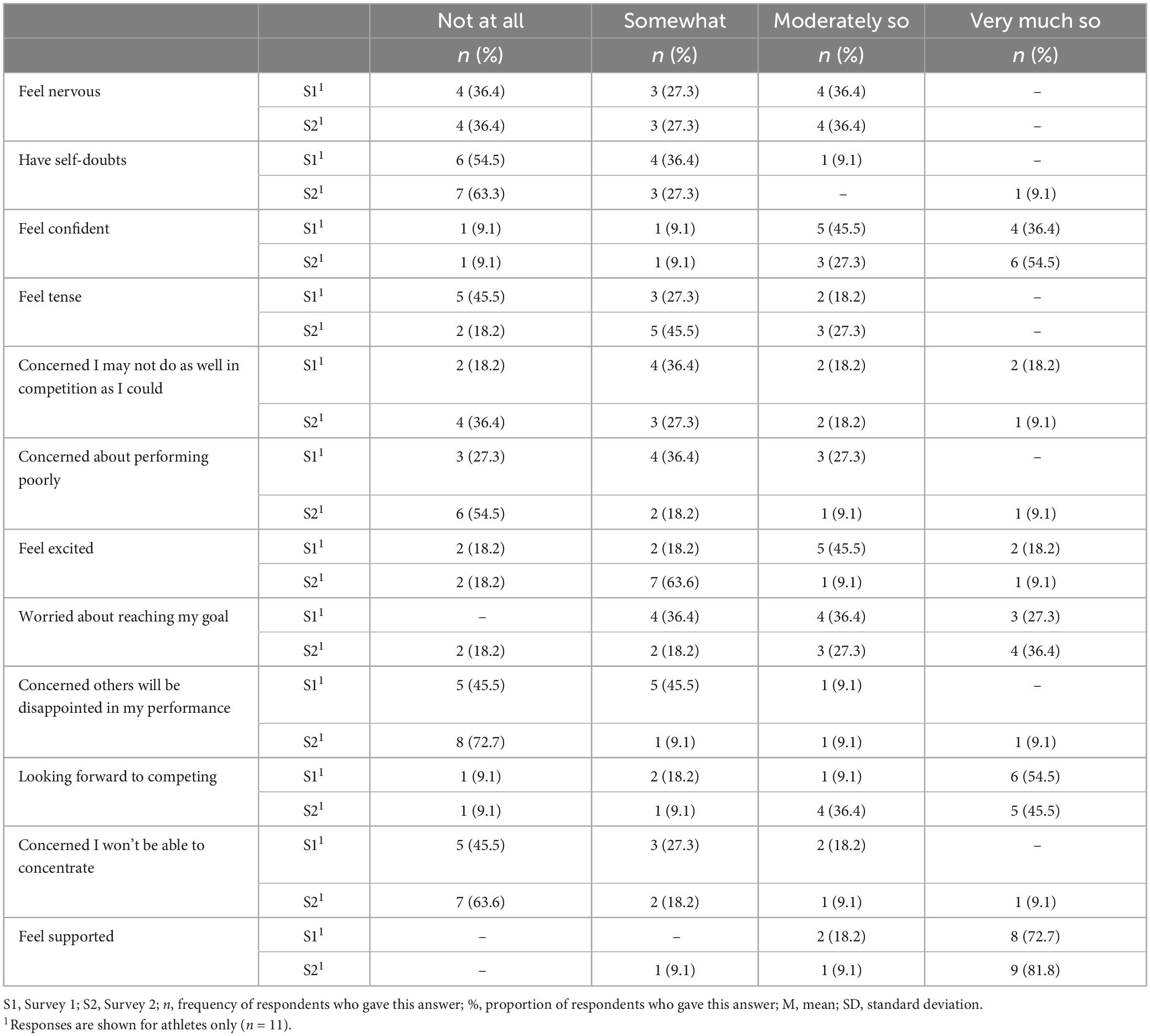
Table 6. Competition-related emotions in Survey 1 and Survey 2 in the 11 athletes competing in the Warrior games.
Motivational factors
A majority considered the opportunity to raise awareness of the current situation in their country (n = 13), to represent their country (n = 11), and spend time with other veterans with disabilities (n = 8) to be “extremely important” motivational factors (Table 7). In contrast, the opportunity to demonstrate their abilities to others and make friends and family proud appeared less important, with 3 participants (16.7%), respectively, rating these items as “not at all important.”
Perceived sources of support
Support from family (M = 5.35, SD = 1.54), sports coaches and trainers (M = 5.25, SD = 1.24), and friends (M = 4.88, SD = 1.54) were considered most important during preparations for the Games (Table 3). Family elicited the greatest number of “completely important” responses (n = 14, 77.8%). Religion or spirituality (M = 3.63, SD = 2.22), and the sports psychologist (M = 3.67, SD = 2.09), were considered least important as sources of support, although the same number of respondents (n = 5, 27.8%) considered religion and spirituality to be “not at all important” as “completely important.”
Discussion
Sleep quality and duration were maintained at S2 for the majority of the sample (Table 2). However, mean sleep duration at both timepoints was lower than the current recommendations of 7–9 h for adults (National Center for Chronic Disease Prevention [CPD], 2017). Literature documents the negative impact of active military duty on sleep and circadian patterns (Shattuck et al., 2018), and of sports training camps on both sleep efficiency and sleep duration (Pitchford et al., 2017; Thornton et al., 2017). One study found that, whilst time in bed increased during a training camp for Australian football players, hours of actual sleep did not (Pitchford et al., 2017). It is possible that respondents’ prior participation in active combat and a full week of training had already restricted sleep duration by the time of S1. It should also be noted that several respondents were living with disability; over a third reported a disability that affected mobility, and just under a third reported a VI. Disability in general, and VI specifically (Peltzer and Phaswana-Mafuya, 2017), have often been associated with poorer sleep, including too much or too little sleep and lower subjective sleep quality. This may be of particular significance for the current sample, for whom exposure to a high intensity training programme and different time zones for both training and the upcoming event may have increased the importance of optimal recovery and their overall sleep requirement (Esteves et al., 2019). Indeed, whilst sleep duration did not decrease between the two surveys, some indicated poorer daytime functioning at S2. Whilst physical activity is generally found to enhance sleep (Driver and Taylor, 2000), increased levels of physical activity without a simultaneous increase in sleep duration may have meant that for some, their sleep requirements were not met during this time. The potential negative physical and psychological outcomes of poor sleep have been evidenced elsewhere in athletes, including altered perceptions of exertion (Fullagar et al., 2015), negative impacts on mood and sporting performance (Fullagar et al., 2015), and increased injury risk due to greater daytime dysfunction (Mah et al., 2018).
As with sleep, well-being and mood remained largely the same across the two surveys. There is evidence that personnel involved in military combat often experience guilt, associated with enjoying one’s life whilst comrades might not be so fortunate (Castro et al., 2015). It is easy to envision how such feelings might be fostered within the environment of a UK-based training camp when one’s unit remained engaged in active combat. However, most participants did not feel guilty, or only some of the time at both timepoints. A full and demanding training programme, and participants’ view of the Games as a means of assisting with Ukraine’s war efforts, may have mediated feelings of guilt. In contrast, there was an increase in the number of participants who felt anxious at least “some of the time,” and a decrease in those who felt anxious “none or almost none of the time.” It is perhaps surprising that anxiety did not decrease. Research has evidenced the deteriorations in psycho-emotional status associated with the onset of the ongoing conflict in Ukraine (Kurapov et al., 2022), and the link between combat duties and increased anxiety in military personnel (Pietrzak et al., 2012). Whilst the training camp offered time away from the conflict and any military duties, sports camps are associated with high levels of both physical and mental fatigue (Buchheit et al., 2013). By S2, respondents had spent several weeks away from home, family and comrades. The negative impacts of itinerant work and separation from support networks has been documented in both military and sporting literature (Wiens and Boss, 2006; Dehghansai et al., 2021). It is possible that competition-related emotions may have also influenced anxiety. The majority of respondents indicated that they felt more tense by S2, levels of excitement did not improve for any respondents, and nervousness increased for a greater number than it improved. These emotions may have been heightened due to the immanency of the Games at S2. Whilst participation in veteran sporting activities has been associated with psychological benefits (Laferrier et al., 2017; Walter et al., 2021), such events have also been found to increase stress and negative emotions such as anger, and to decrease positive emotions such as excitement (Roberts et al., 2019). It is notable that more respondents improved on performance-related items (e.g., concerns about doing well and disappointing others). This suggests that, whilst feelings of nervousness and tension were present, overall, the team felt prepared for the Games. Feeling nervous is common in athletes prior to competitions and may, in fact, be useful if managed effectively, offering individuals increased perceptions of control and a focus for positive mental imagery (Wadey and Hanton, 2008).
Despite the physical separation, family was considered the most important source of support during respondents’ preparations. Yet, the expectations of family members in relation to competition outcomes were of little importance. This reflects existing evidence of the grounding role played by family and significant others during periods of training and competition (Kristiansen and Roberts, 2010; Özdemir, 2019) providing a source of love and support that is not contingent on success or performance (Hellstedt, 2005).
Respondents acknowledged the importance of several factors in their decision to participate in the Games, many of which reflected those identified in existing research on veteran sporting events: to improve health and well-being, achieve a goal, and to reconnect with military life (Sporner et al., 2009; Roberts et al., 2021). The opportunity to spend time with other veterans with disability was considered an extremely important factor in several participants’ decisions to attend the Games, further evidencing the value of being able to bond with individuals with similar experiences for attendees at veteran sporting events (Sporner et al., 2009; Roberts et al., 2021). Team Ukraine’s participation in the Warrior Games comes at a unique time in their history, and results suggest that respondents also sought the opportunity to represent their country and raise awareness of the ongoing conflict on an international stage. This highlights the continued role of sporting events, and sports more generally, as socio-political platforms of protest and demonstration (Kaufman and Wolff, 2010).
Limitations and future research
This paper offers insight into the experiences of a small but unique cohort of Warrior Games attendees. This means that findings may not be generalisable to a broader veteran sample, and the small sample size meant that comparative analysis was not possible. However, it does provide novel insight into the experiences associated with sports participation during times of conflict for veterans and military personnel, and the unique role it might fulfil during this time. Given the importance of participating as a means of raising awareness and representing one’s country in the current study, consideration of the perceptions of other competing teams would be useful in establishing if, and how, Team Ukraine achieved these goals through their participation. Such research would contribute not only to a better understanding of the impact of veterans’ sports participation on the individual, but also the wider political implications of national representation at such events. Exploration of other nations’ experiences of preparing for veteran sporting events may also be valuable in identifying cultural differences in motivational factors, training approach, attitudes, and impacts of participation.
Results indicated increased daytime dysfunction and changes to some aspects of mood and competition-related emotions. However, data pertaining to the period prior to respondents’ arrival in the UK, or during the Games, was not available, and the time between surveys was small. Furthermore, it was not possible to deliver S1 immediately on participants’ arrival in the UK, due to the context of their arrival and the prioritisation of the mental and physical well-being of participants and the start of their training schedule. The current project needed to be designed and delivered within a small timeframe to ensure access to this unique sample population, with continued uncertainty regarding if, and when, team Ukraine would arrive in the UK. Whilst future research which seeks to gather data on health and well-being prior to training camps and beyond participation in sporting events would be beneficial, the realities of doing so with the current sample, many of whom were engaged in active armed conflict prior to the training camp and would return to these duties following the Games, meant that this was not possible in the current study. Future research which considers sleep, and other health and well-being markers, during disabled veterans’ participation in sports and exercise activities, training camps, and competitions, could be used to inform the development of effective schedules of training and rest, ensuring enjoyment, positive health and well-being outcomes, and optimum recovery and performance.
Conclusion
This study offers insight into the health and well-being of the Ukrainian 2022 Warrior Games team during a UK-based training camp. Results showed that sleep, mood, and competition-related emotions remained largely similar over the course of the camp, although, sleep duration was low at both time points and daytime dysfunction increased, along with feelings of nervousness and tension. This was despite participants indicating that overall, they felt prepared for the Games. Despite the physical separation from loved ones, family was considered an important source of support during the training camp. Respondents perceived the Games as a platform on which to raise awareness of the ongoing war. This demonstrates the role played by sporting events in addressing not only personal goals, but also a shared political agenda. Future research should seek to establish the incidence of, and mechanisms underlying, positive and negative psychological experiences and associated changes in markers of health and well-being prior to, during, and following participation in veteran sporting events. This would help to inform the design of training and support programmes for veteran-athletes, with implications for other amateur and disabled athlete groups.
Data availability statement
The raw data supporting the conclusions of this article will be made available by the authors, without undue reservation.
Ethics statement
Ethical review and approval was not required for the study on human participants in accordance with the local legislation and institutional requirements. The patients/participants provided their written informed consent to participate in this study.
Author contributions
CC and RG conceptualised the study. CC, RG, and NH contributed to study design, methodology, reviewed, and edited the manuscript. CC and NH designed the survey, collected and analysed data, and managed the project. CC wrote the first draft of the manuscript. All authors contributed to the article and approved the submitted version.
Funding
This project was funded by a donation from Lord Ashcroft KCMG PC.
Acknowledgments
We thank the Team Ukraine for participating in this study, and Iuliia Bondar for checking translations.
Conflict of interest
The authors declare that the research was conducted in the absence of any commercial or financial relationships that could be construed as a potential conflict of interest.
Publisher’s note
All claims expressed in this article are solely those of the authors and do not necessarily represent those of their affiliated organizations, or those of the publisher, the editors and the reviewers. Any product that may be evaluated in this article, or claim that may be made by its manufacturer, is not guaranteed or endorsed by the publisher.
References
Addison, O., Serra, M. C., Katzel, L., Giffuni, J., Lee, C. C., Castle, S., et al. (2019). Mobility improvements are found in older veterans after 6 months of gerofit regardless of body mass index classification. J. Aging Phys. Act. 27, 848–854. doi: 10.1123/japa.2018-0317
Bennett, J. L., Piatt, J. A., and Van Puymbroeck, M. (2017). Outcomes of a therapeutic fly-fishing program for veterans with combat-related disabilities: a community-based rehabilitation initiative. Commun. Ment. Health J. 53, 756–765. doi: 10.1007/s10597-017-0124-9
Briggs, B. C., and Oursler, K. K. (2021). Pilot study of functional circuit exercise in older adults. Res. Sports Med. 1–6. doi: 10.1080/15438627.2021.1966006
Brittain, I., Bunds, K., and Bocarro, J. (2022). The contribution of sport in the rehabilitation process of disabled military veterans: a case study of the 2016 Invictus games. J. Glob. Sport Manag. 1–24. doi: 10.1080/24704067.2022.2031249
Buchheit, M., Racinais, S., Bilsborough, J., Bourdon, P., Voss, S., Hocking, J., et al. (2013). Monitoring fitness, fatigue and running performance during a pre-season training camp in elite football players. J. Scie. Med. Sport 16, 550–555. doi: 10.1016/j.jsams.2012.12.003
Buysse, D. J., Reynolds, C. F. III, Monk, T. H., Berman, S. R., and Kupfer, D. J. (1989). The Pittsburgh sleep quality index: a new instrument for psychiatric practice and research. Psychiatry Res. 28, 193–213. doi: 10.1016/0165-1781(89)90047-4
Caddick, N., and Smith, B. (2014). The impact of sport and physical activity on the well-being of combat veterans: a systematic review. Psychol. Sport Exerc. 15, 9–18.
Castro, C. A., Kintzle, S., and Hassan, A. M. (2015). The combat veteran paradox: paradoxes and dilemmas encountered with reintegrating combat veterans and the agencies that support them. Traumatology 21, 299–310.
Craig, P. J., Alger, D. M., Bennett, J. L., and Martin, T. P. (2020). The transformative nature of fly-fishing for veterans and military personnel with posttraumatic stress disorder. Ther. Recreat. J. 54, 150–172.
Crawford, R. T. (2016). The Impact of Ocean Therapy on Veterans With Posttraumatic Stress Disorder. Phoenix, AZ: Grand Canyon University.
Dehghansai, N., Pinder, R., Baker, J., and Renshaw, I. (2021). Challenges and stresses experienced by athletes and coaches leading up to the Paralympic games. PLoS One 16:e0251171. doi: 10.1371/journal.pone.0251171
Esteves, A. M., Pancotto, H. P., and Silva, A. N. (2019). Extension and restriction of sleep time in the physical performance of athletes with visual and intellectual disabilities: new possibilities. Br. J. Mot. Behav. 13, 104–112.
European Social Survey (2010). ESS5 Questionnaires UA (Ukr). Available online at: https://stessrelpubprodwe.blob.core.windows.net/data/round5/fieldwork/ukraine/ukrainian/ESS5_questionnaires_UA_ukr.pdf (accessed June 23, 2022).
Fullagar, H. H., Skorski, S., Duffield, R., Hammes, D., Coutts, A. J., and Meyer, T. (2015). Sleep and athletic performance: the effects of sleep loss on exercise performance, and physiological and cognitive responses to exercise. Sports Med. 45, 161–186.
Gelkopf, M., Hasson-Ohayon, I., Bikman, M., and Kravetz, S. (2013). Nature adventure rehabilitation for combat-related posttraumatic chronic stress disorder: a randomized control trial. Psychiatry Res. 209, 485–493. doi: 10.1016/j.psychres.2013.01.026
Hellstedt, J. (2005). Invisible players: a family systems model. Clini. in Sports Med. 24, 899–928. doi: 10.1016/j.csm.2005.06.001
Kaufman, P., and Wolff, E. A. (2010). Playing and protesting: sport as a vehicle for social change. J. Sport Soc. Issues 34, 154–175.
Kristiansen, E., and Roberts, G. C. (2010). Young elite athletes and social support: coping with competitive and organizational stress in “Olympic” competition. Scandi. J. Med. Sci. Sports 20, 686–695. doi: 10.1111/j.1600-0838.2009.00950.x
Kurapov, A., Pavlenko, V., Drozdov, A., Bezliudna, V., Reznik, A., and Isralowitz, R. (2022). Toward an understanding of the Russian-Ukrainian war impact on university students and personnel. J. Loss Trauma 28, 167–174.
Laferrier, J., Teodorski, E., Sprunger, N., Cooper, R., and Schmeler, M. (2017). Investigation of the impact of sports, exercise and recreation (ser) participation on psychosocial outcomes in a population of veterans with disabilities using the sports outcome research tool and comprehensive uniform survey (Sportacus). A longitudinal survey. J. Novel Physiother. 7, 1–12.
Lundberg, N., Taniguchi, S., McGovern, R., and Smith, S. (2016). Female veterans’ involvement in outdoor sports and recreation: a theoretical sample of recreation opportunity structures. J. Leisure Res. 48, 413–430.
Madrigal, L. A., Roma, V., Caze, T., Maerlender, A., and Hope, D. (2018). Factor structure and gender invariance testing for the Sport Anxiety Scale-2 (SAS-2). J. Clin. Sport Psychol. 12, 201–217. doi: 10.1123/jcsp.2016-0036
Mah, C. D., Kezirian, E. J., Marcello, B. M., and Dement, W. C. (2018). Poor sleep quality and insufficient sleep of a collegiate student-athlete population. Sleep Health 4, 251–257. doi: 10.1016/j.sleh.2018.02.005
National Center for Chronic Disease Prevention [CPD] (2017). How Much Sleep Do I Need?, 2017. Available online at: https://www.cdc.gov/sleep/about_sleep/how_much_sleep.html (accessed October 10, 2022).
Office for National Statistics (2018). Personal Well-Being User Guidance. Available online: https://www.ons.gov.uk/peoplepopulationandcommunity/wellbeing/methodologies/personalwellbeingsurveyuserguide (accessed June 20, 2022).
Özdemir, N. (2019). The investigation of elite athletes’ psychological resilience. J. Educ. Training Stud. 7, 47–57.
Peltzer, K., and Phaswana-Mafuya, N. (2017). Association between visual impairment and low vision and sleep duration and quality among older adults in South Africa. Int. J. Environ. Res. Public Health 14:811. doi: 10.3390/ijerph14070811
Peterson, S. L., Laferrier, J. Z., Koontz, A. M., Wang, H., Hannan, M., and Cooper, R. A. (2017). Psychological strategies of veterans and service members who participate in organized sports. J. Mil. Veteran Fam. Health 3, 42–52.
Pietrzak, E., Pullman, S., Cotea, C., and Nasveld, P. (2012). Effects of deployment on mental health in modern military forces: a review of longitudinal studies. J. Mil. Veterans Health 20, 24–36.
Pitchford, N. W., Robertson, S. J., Sargent, C., Cordy, J., Bishop, D. J., and Bartlett, J. D. (2017). Sleep quality but not quantity altered with a change in training environment in elite Australian rules football players. Int. J. Sports Physiol. Perform. 12, 75–80.
Roberts, G. A., Arnold, R., Gillison, F., Colclough, M., and Bilzon, J. (2021). Military veteran athletes’ experiences of competing at the 2016 Invictus games: a qualitative study. Disabil. Rehabil. 43, 3552–3561. doi: 10.1080/09638288.2020.1725655
Roberts, G. A., Arnold, R., Turner, J. E., Colclough, M., and Bilzon, J. (2019). A longitudinal examination of military veterans’ Invictus games stress experiences. Front. Psychol. 10:1934. doi: 10.3389/fpsyg.2019.01934
Shattuck, N. L., Matsangas, P., and Dahlman, A. S. (2018). “Sleep and fatigue issues in military operations,” in Sleep and Combat-Related Post Traumatic Stress Disorder, eds E. Vermetten, A. G. Thomas, and C. Neylan (New York, NY: Springer), 69–76.
Smith, R. E., Smoll, F. L., Cumming, S. P., and Grossbard, J. R. (2006). Measurement of multidimensional sport performance anxiety in children and adults: the sport anxiety scale-2. J. Sport Exerc. Psychol. 28, 479–501. doi: 10.1186/s12913-016-1423-5
Sporner, M. L., Fitzgerald, S. G., Dicianno, B. E., Collins, D., Teodorski, E., Pasquina, P. F., et al. (2009). Psychosocial impact of participation in the national veterans wheelchair games and winter sports clinic. Disabil. Rehabil. 31, 410–418. doi: 10.1080/09638280802030923
Thornton, H. R., Duthie, G. M., Pitchford, N. W., Delaney, J. A., Benton, D. T., and Dascombe, B. J. (2017). Effects of a 2-week high-intensity training camp on sleep activity of professional rugby league athletes. Int. J. Sports Physiol. Perform. 12, 928–933. doi: 10.1123/ijspp.2016-0414
Wadey, R., and Hanton, S. (2008). Basic psychological skills usage and competitive anxiety responses: perceived underlying mechanisms. Res. Q. Exerc. Sport 79, 363–373. doi: 10.1080/02701367.2008.10599500
Walter, K. H., Otis, N. P., Del Re, A., Kohen, C. B., Glassman, L. H., Ober, K. M., et al. (2021). The national veterans summer sports clinic: change and duration of psychological outcomes. Psychol. Sport Exerc. 55:101939.
Wheeler, M., Cooper, N. R., Andrews, L., Hacker Hughes, J., Juanchich, M., Rakow, T., et al. (2020). Outdoor recreational activity experiences improve psychological wellbeing of military veterans with post-traumatic stress disorder: positive findings from a pilot study and a randomised controlled trial. PLoS One 15:e0241763. doi: 10.1371/journal.pone.0241763
Keywords: competition, sports, disability, veteran, sleep, military, well-being, mood
Citation: Castle CL, Heinze N and Gomes RSM (2023) A cross-sectional study of sleep, mood, well-being, motivations, and perceived support in Ukrainian veterans and active-duty military personnel with disability, and their supporters, preparing for a sporting event. Front. Psychol. 14:1089735. doi: 10.3389/fpsyg.2023.1089735
Received: 04 November 2022; Accepted: 06 March 2023;
Published: 23 March 2023.
Edited by:
Derek M. Peters, University of Worcester, United KingdomReviewed by:
Aurelio Olmedilla, University of Murcia, SpainJustin Laferrier, The University of Rhode Island, United States
Copyright © 2023 Castle, Heinze and Gomes. This is an open-access article distributed under the terms of the Creative Commons Attribution License (CC BY). The use, distribution or reproduction in other forums is permitted, provided the original author(s) and the copyright owner(s) are credited and that the original publication in this journal is cited, in accordance with accepted academic practice. No use, distribution or reproduction is permitted which does not comply with these terms.
*Correspondence: Renata S. M. Gomes, cmVuYXRhLmdvbWVzQGJyYXZvdmljdG9yLm9yZw==
 Claire L. Castle
Claire L. Castle Nikki Heinze
Nikki Heinze Renata S. M. Gomes
Renata S. M. Gomes